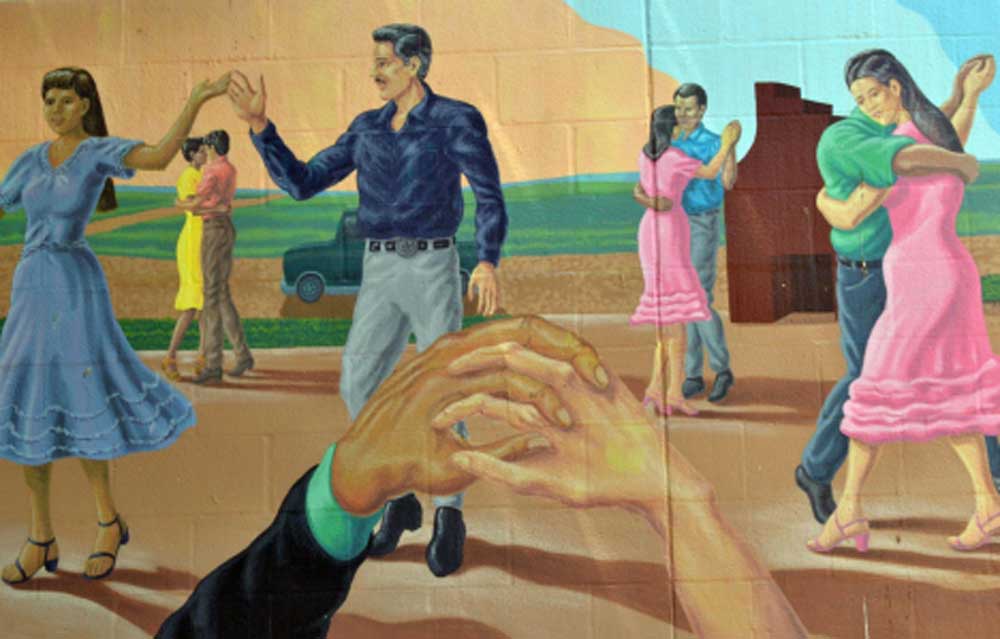Texas artist Fidencio Duran has been climbing tall scaffolds since he won a commission to complete a mural in Brownsville, Texas thirty-seven years ago. Today, Duran’s murals are among the most visible for any Latino artist in America. On an annual basis millions see his colorful mural, “The Visit,” above the American,
Continental, and United Airlines ticket counters at the Austin International Airport. City of Austin officials predict that 20 million travelers will walk through the airport corridors in 2022. Such visibility is making Latino art important to the American art scene.
Duran’s murals in East Austin are well known for providing a visual historical narrative of Texas-Mexicans or Tejanos. Tejano is a term popular among many Latinos of Mexican background living in Texas. In his community
murals, Duran traces the historical path of Tejanos and Indigenous people over the past three centuries. His most visible East Austin murals are at Montopolis Recreational and Community Center, the Holly Street Power Plant, and the El Centro Campus of the Austin Community College. He is also featured as a muralist at the Dell Children’s Medical Center and Dell/Seton Hospital at UT Austin.
Duran grew up in Lockhart, an old ranching
community 30 miles south of Austin. The town is particularly noted for its great Texas barbecue. In 1999 the Texas Legislature proclaimed Lockhart as the “Barbecue Capital of Texas.” During Duran’s early school years, Lockhart, with a population of fewer than ten thousand residents, qualified as a small rural town. The community had one high school where Latinos constituted an estimated one-fourth of the student body.
Lockhart was surrounded by cattle ranches and agricultural farms for much of the 20th century. The rural characteristics of the region and the people living there are captured in many of Duran’s murals and paintings. Many of his subjects are inspired by the stories his father told him about immigrating from Mexico and “living and working as a tenant farmer.” Duran wrote in his Artist
Statement that he seeks to “honor the history of his family and community in visual stories.”
Duran’s first school prize was actually in writing. In the sixth grade, he won first place in a University Interscholastic League competition for an essay that asked the young students to write about whom they most admired. He chose to write about his dad, who worked as a janitor at the school he attended.
Early on, art teachers set high expectations for Duran recognizing his high motivation to learn coupled with his gifted artistic abilities. His teachers also made sure the young art student benefited from seeing the work of great artists. His teachers organized field trips to Dallas and the University of Texas Austin art museums.
In high school, Duran had the good fortune of meeting Ricardo Hernandez, an Austin artist who befriended him and served as a mentor during his early years. Hernadez, a University of Texas at El Paso [UTEP] graduate, recommended the border city campus to Duran. Enrolling at UTEP in the fall of 1979, Duran fell in love with his art classes. He studied with Dr. Robert Massey who provided superb instruction in drawing, composition, and perspective. Duran learned the elements of design, a skill that would serve him well in later years in mural painting.
Duran returned to Austin after two years in El Paso and graduated in 1984 with a degree in Fine Arts from the University of Texas. The following year Duran received funding from the Texas Commission of the Arts to paint a mural in Brownsville, Texas, a border city near the Gulf of Mexico. The Commission designated La Esperanza, a home for girls, for the mural.
Upon finishing the Brownsville mural, Duran returned to Austin to discover the many challenges of making a living as an artist. He lacked important connections to art galleries and knew little about going about acquiring representation by an agent or gallery. As a result, Duran worked for two years as a line cook at a local Mexican restaurant, painting on his days off.
By 1990 Duran had quit his day job and returned to painting full time. He exhibited across the state and was represented at different times by El Paso, Austin, and Houston galleries. In the late 1990s, he completed his “Cinco de Mayo” mural at the Zaragoza Recreation Center in East Austin. Over the next decade, he participated in exhibits in Chicago; Washington, DC; San Francisco; Buenos Aires, Argentina; and Saltillo, Mexico.
Duran’s large mural at the Austin International Airport is among my favorites. There are nine panels high above the ticket counters occupying an enormous space nine feet high by ninety linear feet long. Among his subjects are a woman watering her garden; two girls playing volleyball; an accordion player flanked by two friends enjoying a fire in an open field; a young man throwing a frisbee to friends; and several men sitting at a table in the backyard playing dominos. In his mural, Duran brings to life ordinary activities, leisure, culture, and traditions of rural Central Texas
While the majority of Duran’s murals are located in Austin, residents of Mercedes and Houston also enjoy his murals in their communities. The narrative work he started in the 1980s won him recognition as the prestigious Texas State Parks’ Centennial Artist for 2018 awarded by the Texas Parks and Wildlife Commission. Duran continues to paint daily and is valued for highlighting the history and cultural traditions of Tejanos.
Fidencio Duran: A Painter Who Captures Latino Culture and Traditions in Everyday Life









